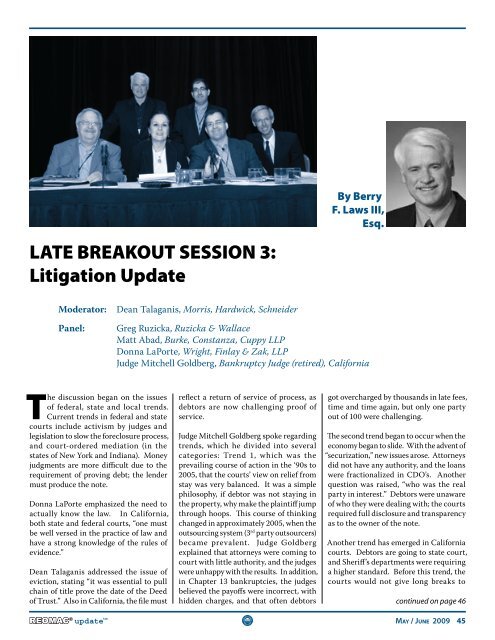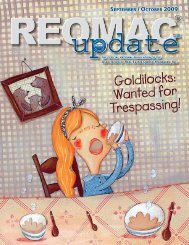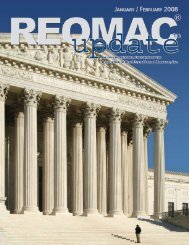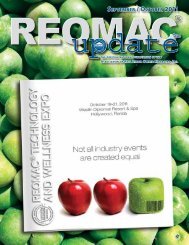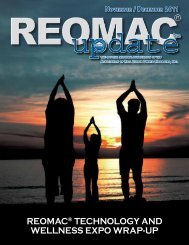Spring Conference Review - reomac
Spring Conference Review - reomac
Spring Conference Review - reomac
Create successful ePaper yourself
Turn your PDF publications into a flip-book with our unique Google optimized e-Paper software.
By Berry<br />
F. Laws III,<br />
Esq.<br />
LATE BREAKOUT SESSION 3:<br />
Litigation Update<br />
Moderator:<br />
Panel:<br />
Dean Talaganis, Morris, Hardwick, Schneider<br />
Greg Ruzicka, Ruzicka & Wallace<br />
Matt Abad, Burke, Constanza, Cuppy LLP<br />
Donna LaPorte, Wright, Finlay & Zak, LLP<br />
Judge Mitchell Goldberg, Bankruptcy Judge (retired), California<br />
The discussion began on the issues<br />
of federal, state and local trends.<br />
Current trends in federal and state<br />
courts include activism by judges and<br />
legislation to slow the foreclosure process,<br />
and court-ordered mediation (in the<br />
states of New York and Indiana). Money<br />
judgments are more difficult due to the<br />
requirement of proving debt; the lender<br />
must produce the note.<br />
Donna LaPorte emphasized the need to<br />
actually know the law. In California,<br />
both state and federal courts, “one must<br />
be well versed in the practice of law and<br />
have a strong knowledge of the rules of<br />
evidence.”<br />
Dean Talaganis addressed the issue of<br />
eviction, stating “it was essential to pull<br />
chain of title prove the date of the Deed<br />
of Trust.” Also in California, the file must<br />
reflect a return of service of process, as<br />
debtors are now challenging proof of<br />
service.<br />
Judge Mitchell Goldberg spoke regarding<br />
trends, which he divided into several<br />
categories: Trend 1, which was the<br />
prevailing course of action in the ‘90s to<br />
2005, that the courts’ view on relief from<br />
stay was very balanced. It was a simple<br />
philosophy, if debtor was not staying in<br />
the property, why make the plaintiff jump<br />
through hoops. This course of thinking<br />
changed in approximately 2005, when the<br />
outsourcing system (3 rd party outsourcers)<br />
became prevalent. Judge Goldberg<br />
explained that attorneys were coming to<br />
court with little authority, and the judges<br />
were unhappy with the results. In addition,<br />
in Chapter 13 bankruptcies, the judges<br />
believed the payoffs were incorrect, with<br />
hidden charges, and that often debtors<br />
got overcharged by thousands in late fees,<br />
time and time again, but only one party<br />
out of 100 were challenging.<br />
The second trend began to occur when the<br />
economy began to slide. With the advent of<br />
“securization,” new issues arose. Attorneys<br />
did not have any authority, and the loans<br />
were fractionalized in CDO’s. Another<br />
question was raised, “who was the real<br />
party in interest.” Debtors were unaware<br />
of who they were dealing with; the courts<br />
required full disclosure and transparency<br />
as to the owner of the note.<br />
Another trend has emerged in California<br />
courts. Debtors are going to state court,<br />
and Sheriff’s departments were requiring<br />
a higher standard. Before this trend, the<br />
courts would not give long breaks to<br />
continued on page 46<br />
REOMAC ® update tm Ma y / Jun e 2009 45


